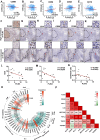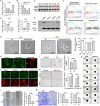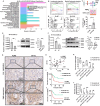Lipid droplets-related Perilipin-3: potential immune checkpoint and oncogene in oral squamous cell carcinoma
- PMID: 38554152
- PMCID: PMC10981595
- DOI: 10.1007/s00262-024-03659-9
Lipid droplets-related Perilipin-3: potential immune checkpoint and oncogene in oral squamous cell carcinoma
Abstract
Background: Lipid droplets (LDs) as major lipid storage organelles are recently reported to be innate immune hubs. Perilipin-3 (PLIN3) is indispensable for the formation and accumulation of LDs. Since cancer patients show dysregulated lipid metabolism, we aimed to elaborate the role of LDs-related PLIN3 in oral squamous cell carcinoma (OSCC).
Methods: PLIN3 expression patterns (n = 87), its immune-related landscape (n = 74) and association with B7-H2 (n = 51) were assessed by immunohistochemistry and flow cytometry. Real-time PCR, Western blot, Oil Red O assay, immunofluorescence, migration assay, spheroid-forming assay and flow cytometry were performed for function analysis.
Results: Spotted LDs-like PLIN3 staining was dominantly enriched in tumor cells than other cell types. PLIN3high tumor showed high proliferation index with metastasis potential, accompanied with less CD3+CD8+ T cells in peripheral blood and in situ tissue, conferring immunosuppressive microenvironment and shorter postoperative survival. Consistently, PLIN3 knockdown in tumor cells not only reduced LD deposits and tumor migration, but benefited for CD8+ T cells activation in co-culture system with decreased B7-H2. An OSCC subpopulation harbored PLIN3highB7-H2high tumor showed more T cells exhaustion, rendering higher risk of cancer-related death (95% CI 1.285-6.851).
Conclusions: LDs marker PLIN3 may be a novel immunotherapeutic target in OSCC.
Keywords: B7-H2; Lipid droplets; OSCC; PD-L1; Perilipin-3.
© 2024. The Author(s).
Conflict of interest statement
The authors have no relevant financial or non-financial interests to disclose.
Figures







Similar articles
-
Lipid droplets' functional protein caveolin-2 is associated with lipid metabolism-related molecule FABP5 and EMT marker E-cadherin in oral epithelial dysplasia.J Clin Pathol. 2024 Apr 18;77(5):330-337. doi: 10.1136/jcp-2022-208673. J Clin Pathol. 2024. PMID: 36854623
-
Structural insights into perilipin 3 membrane association in response to diacylglycerol accumulation.Nat Commun. 2023 Jun 2;14(1):3204. doi: 10.1038/s41467-023-38725-w. Nat Commun. 2023. PMID: 37268630 Free PMC article.
-
Lipid Droplet-Related PLIN2 in CD68+ Tumor-Associated Macrophage of Oral Squamous Cell Carcinoma: Implications for Cancer Prognosis and Immunotherapy.Front Oncol. 2022 Mar 15;12:824235. doi: 10.3389/fonc.2022.824235. eCollection 2022. Front Oncol. 2022. PMID: 35372038 Free PMC article.
-
Plin3 protects against alcoholic liver injury by facilitating lipid export from the endoplasmic reticulum.J Cell Biochem. 2019 Sep;120(9):16075-16087. doi: 10.1002/jcb.28889. Epub 2019 May 22. J Cell Biochem. 2019. PMID: 31119787
-
High glucose, insulin and free fatty acid concentrations synergistically enhance perilipin 3 expression and lipid accumulation in macrophages.Metabolism. 2013 Aug;62(8):1168-79. doi: 10.1016/j.metabol.2013.02.013. Epub 2013 Apr 6. Metabolism. 2013. PMID: 23566650
Cited by
-
Mechanism of apoptosis in oral squamous cell carcinoma promoted by cardamonin through PI3K/AKT signaling pathway.Sci Rep. 2024 Sep 5;14(1):20802. doi: 10.1038/s41598-024-71817-1. Sci Rep. 2024. PMID: 39242879 Free PMC article.
-
The regulatory role and mechanism of energy metabolism and immune response in head and neck cancer.Genes Dis. 2025 Mar 19;12(6):101607. doi: 10.1016/j.gendis.2025.101607. eCollection 2025 Nov. Genes Dis. 2025. PMID: 40821122 Free PMC article. Review.
-
Lipid homeostasis dysregulation in oral cancer drives metabolic reprogramming and offers novel diagnostic and therapeutic opportunities.Discov Oncol. 2025 Aug 25;16(1):1613. doi: 10.1007/s12672-025-03299-0. Discov Oncol. 2025. PMID: 40853574 Free PMC article. Review.
-
The Role of PLIN3 in Prognosis and Tumor-Associated Macrophage Infiltration: A Pan-Cancer Analysis.J Inflamm Res. 2025 Mar 13;18:3757-3777. doi: 10.2147/JIR.S509245. eCollection 2025. J Inflamm Res. 2025. PMID: 40098998 Free PMC article.
References
MeSH terms
Substances
Grants and funding
LinkOut - more resources
Full Text Sources
Medical
Molecular Biology Databases
Research Materials
Miscellaneous

